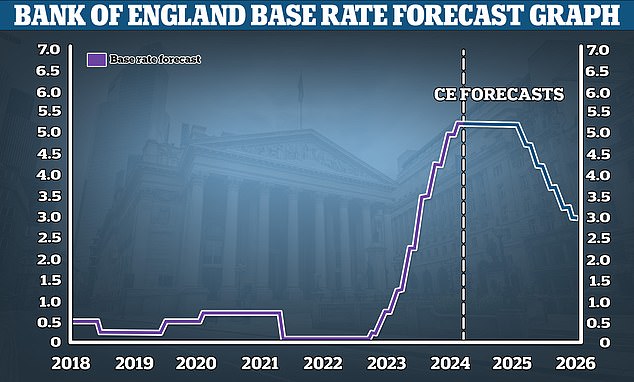
The Bank of England will cut the base rate to around 3 per cent by in 2025, according to the latest forecasts from Capital Economics.
Wider market expectations continue to also all point towards the Bank of England cutting the base rate later in 2024, albeit they have been revised up since the start of the year.
At the start of this year, investors were betting rates could be cut to 3.75 per cent by Christmas.
But it is now thought rates will fall to just 4.5 per cent this year – with the first move expected to come in June.

Future falls: Capital Economics is forecasting the the bank rate will be cut to 3% in 2025
The Office for National Statistics said inflation held firm at 4 per cent in January, defying forecasts that inflation would rise.
With inflation expected to fall over the coming months, analysts remain busy trying to predict when the first base rate cut will come.
The general consesus across the market thar the first rate cut will happen in June this year.
How low it will go after that is that is anyone’s guess, but general market predictions suggest it could reach a low of 3.75 per cent over the coming years.
Capital Economics is a little more punchy. Its economists are predicting that base rate will fall to 3 per cent by the end of next year.
Between December 2021 and August 2023, the Bank of England’s Monetary Policy Committee upped base rate on 14 consecutive occasions from 0.1 per cent to 5.25 per cent.
However, since August, the MPC has opted to hold base rate at 5.25 per cent.
Market expectation around where base rate would peak fell from a high of 6.5 per cent in the summer to 5.25 per cent very quickly in early autumn last year.
What the future holds for interest rates will greatly depend on the the outlook of the UK economy, how quickly inflation falls, alongside wage growth and unemployment.
The UK economy grew by 0.2 per cent in January, according to the Office of National Statistics, following a fall of 0.1 per cent in December 2023.
Watch what the Fed does
UK base rate moves have tended to mirror the Federal Reserve in the US.
It makes sense to be moving in a similar direction to other central banks, such as the Fed and the European Central Bank (ECB) to keep the pound competitive.
How the US economy and inflation develops over the coming year and what the Fed does in response will therefore play a major role in what happens over here.
In January, inflation in the US was at 3.1 per cent and not falling as quickly as anticipated – denting the prospect of early action by the Federal Reserve.
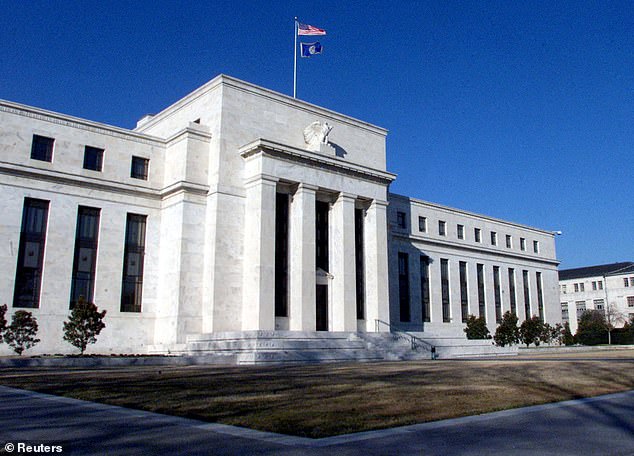
Inflation slowing: in January, the US Central bank held rates at the 5.25-5.5 per cent range and the following day the Bank of England also held base rate at 5.25 per cent
In January, the US Central bank held rates at the 5.25-5.5 per cent range and the following day the Bank of England also held base rate at 5.25 per cent.
Paul Dales, chief economist at Capital Economics says: ‘The Bank of England is looking at the same issues as the Fed so it might be the case that they move broadly in tandem.
‘That said, it is possible that domestic inflation (wage growth and services CPI inflation) will take a bit longer to fall in the UK than in the US.
‘Equally, though, the UK economy is not as strong as the US economy. But if the Fed were to cut rates, that would put a bit of pressure on the BoE to follow suit.’
What could cause the base rate to be cut?
For almost two years, the Bank of England attempted to combat rising inflation by continually upping the base rate.
With inflation forecast to fall further over the coming months, this will remove the core reason for the base rate rising in the first place.

An welcome surprise: January’s CPI inflation reading stuck at 4% instead of the predicted 0.2% rise
The current assumption by the independent economic research business, Capital Economics, is that now that rates have peaked and set to fall from here on in.
Paul Dales of Capital Economics thinks the first cut will come in June.
He says: ‘We are still pencilling it in for June and have assumed rates are cut by 25bps then and by 25bps at every subsequent meeting until they reach 3 per cent.
‘The June forecast is based on the idea that by then CPI inflation will have fallen below 2 per cent (in April we think) and that other measures of the persistence of inflation, such as CPI services inflation and wage growth, will also have eased significantly from current levels.
‘If we are wrong about the first cut in June, it’s more likely to be later than earlier as wage growth and services CPI inflation ease more slowly than we expect or the Bank of England just wants to wait for inflation to be lower before cutting interest rates. ‘
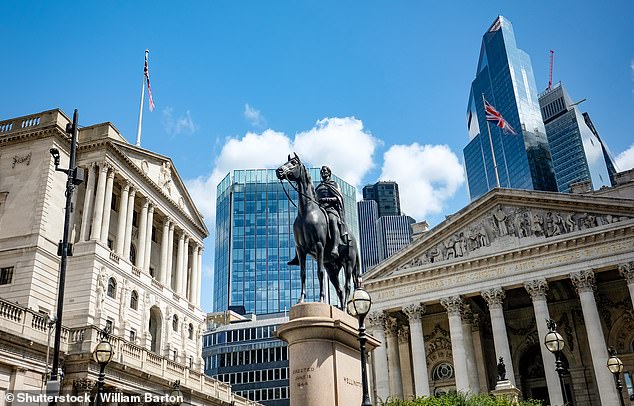
Fourth time in a row: The Bank of England has opted once again to hold the base rate at 5.25%
So what does this mean for your interest rates?
Many people assume that savings rates and mortgage rates are directly linked to the Bank of England base rate.
In reality, future market expectations for interest rates and banks’ funding and lending targets and appetite for business are what really matters.
Market interest rate expectations are reflected in swap rates. A swap is essentially an agreement in which two banks agree to exchange a stream of future fixed interest payments for another stream of variable ones, based on a set price.
These swap rates are influenced by long-term market projections for the Bank of England base rate, as well as the wider economy, internal bank targets and competitor pricing.
In aggregate, swap rates create something of a benchmark that can be looked to as a measure of where the market thinks interest rates will go.

Cause and effect: Inflation and wage growth are both factors that could determine what the Bank of England will do with base rate in the future
Current swap rates suggest that interest rates will be lower over the coming years, but not dramatically so.
Five-year swaps are currently at 3.91 per cent and two-year swaps at 4.48 per cent – both trending well below the current base rate.
Only as recently as July, five-year swaps were above 5 per cent. Similarly, the two-year swaps were coming in around 6 per cent.
However, they are slightly up compared to the start of the year when five-year swaps were 3.4 per cent and two-year swaps were 4.04 per cent.
Any borrowers hoping for a return to the rock bottom interest rates of 2021 will likely be disappointed. On the flipside, savers will be reassured that rates are not expected to plummet to the depths again.
That said, fixed rate savings deals have taken a hit over the past six months.
The average one-year fixed-rate bond has fallen to 4.59 per cent, down from a high of 5.45 per cent in October.
The days of 6.2 per cent one-year rates are well and truly over for savers as the top one-year bonds now offer just over 5 per cent.

Roll the dice: Current swap rates suggest that interest rates will be lower over the coming years
It’s worth pointing out that while swap rates are a good metric for where markets think interest rates are going, they also change rapidly in response to economic changes.
Richard Carter of Quilter Cheviot adds: ‘Swap rates are a useful indicator of current expectations, but it is important to remember they are no better at predicting the future than any other economic indicator. The economic outlook can change very quickly and very dramatically.’
What should savers do?
Moving your money to a new savings account is much easier than many people think.
It can all be done online and setting up an account can often take less than 10 minutes.
So our advice is simple. Don’t be loyal to your bank or savings provider. Be proactive and hunt for the best rates using our independent best buy tables.
Savers can get as high as 5.11 per cent in an easy-access account or 5.28 per cent on fixed rate savings deals at the moment.
With inflation now at 4 per cent it means savers who hold their cash in the top paying accounts will be making a real return.
Our savings tables show the best easy-access savings and fixed rate savings deals.
The advice to savers has been to keep on top of the changing market if they want to secure a competitive deal.
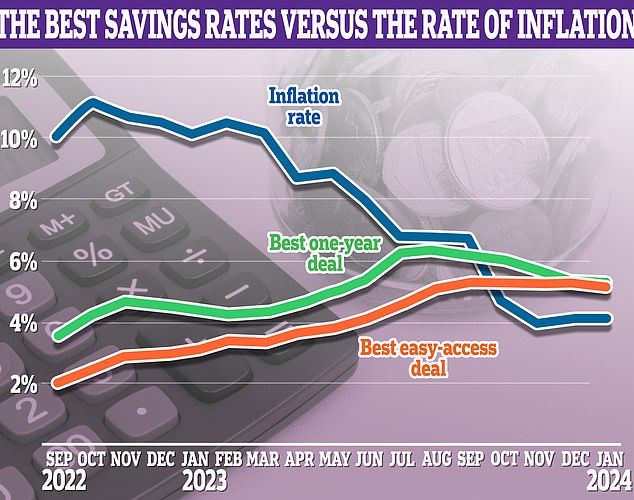
Keeping an eye on inflation is key to knowing whether or not your savings are being eaten away by inflation
Rachel Springall, finance expert at Moneyfacts, said: ‘Despite recent cuts to fixed rate savings, it is worth noting that average rates are higher than they were at the start of 2023, so many coming off a fixed rate will find better returns today if they want to lock into a deal of a similar term.
‘Longer-term fixed rates are currently returning less than one-year options on average, but with interest rates expected to fall this year, some savers may decide to fix for longer.
‘Savers who prefer to keep their cash closer to hand will find easy access variable rates are much higher now than they were a year ago, but returns have dipped slightly month-on-month.
‘Savings providers will no doubt be aware of the ongoing murmurings of the Bank of England base rate coming down in 2024, but even if this doesn’t occur for the next few months, variable rates can still change.
‘Providers will be looking closely both at their interest margins, the swap market, and their own position in the top rate tables against their peers.
‘Swift movement can take place if they are sitting way ahead of their competition or if they are drawing in too much in deposits.’
Paul Dales of Capital Economics adds: ‘Savings rates have already started to decline due to expectations that Bank Rate will be cut later this year.
‘If our forecasts for Bank Rate are correct, then savings rates have further to fall.’
What about mortgage borrowers?
Mortgage borrowers on fixed term deals should worry less about the base rate changes, and more about where markets are forecasting the base rate to go in the future.
This is because banks tend to pre-empt the base rate hike. They change their fixed mortgage rates on the back of predictions about how high the base rate will ultimately go, and how long inflation will last for.
Mortgage rates started the year on a downward trajectory, with markets having lowered their expectations of where the Bank of England’s base rate will peak.
In January alone, more than 50 mortgage lenders have cut residential rates, taking the cheapest fixed rates below 4 per cent.
However, since 1 February the average two-year fix has risen from 5.56 to 5.8 per cent following the Bank of England’s decision to hold base rate at the start of the month.
Meanwhile the average five-year fix has risen from 5.18 per cent to 5.35 per cent since 1 February. The lowest fixed rates are now above 4 per cent.
The sudden shift upwards has come thanks to a slight change in market expectations around future interest rates.
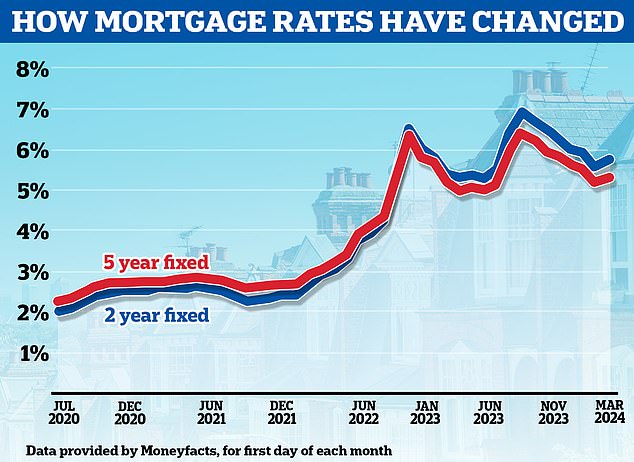
Going back up: Mortgage rates have begun rising again after falling back from the highs they reached in the summer
As a result of this repricing upwards, people attempting to sort their mortgage are finding the best deals are not staying around for long.
The average shelf-life of a mortgage product has plummeted to 15 days, according to Moneyfacts, down from 28 days at the start of last month.
This is the lowest average recorded in six months and not far off the record low of 12 days in July 2023 when mortgage rates reached their peak.
Rachel Springall, finance expert at Moneyfacts, said: ‘Lenders reacted to the change in swap rates, leading to numerous repricing of fixed rate deals, no doubt making it a challenging situation for borrowers and brokers to keep on top of the changes.
‘The rate volatility led to a rise in both the overall average two- and five-year fixed rates, the opposite direction borrowers may well have hoped for after positive rate cuts recorded a month prior.
‘However, it is worth noting that fixed rates remain lower than at the start of 2024 and there are still some decent options available for borrowers to compare.’
What to do if you need to remortgage
While most people will remain protected for interest rate changes until their fixed rate deal ends, 1.6 million Britons are set to come to the end of their existing deal this year, according to UK Finance.
Those coming to the end of their fixed rate mortgage deals are in danger of falling on rates up to 10 times higher than they are currently on.
If they don’t remortgage to a new deal before their two or five-year fixed rate deals end, they will revert to their lenders’ standard variable rate (SVR).
SVRs can be as high as 9.73 per cent depending on the lender, and can add hundreds or even thousands of pounds to someone’s monthly repayments.
To avoid this nasty payment shock, borrowers need to organise ahead of time by either remortgaging to a different lender before their deal ends, or switching to another deal with their existing bank or building society in what is known as a product transfer.
However, there is no escaping the fact they will face considerably higher monthly payments in any case – but avoiding their SVR will at least limit the damage.
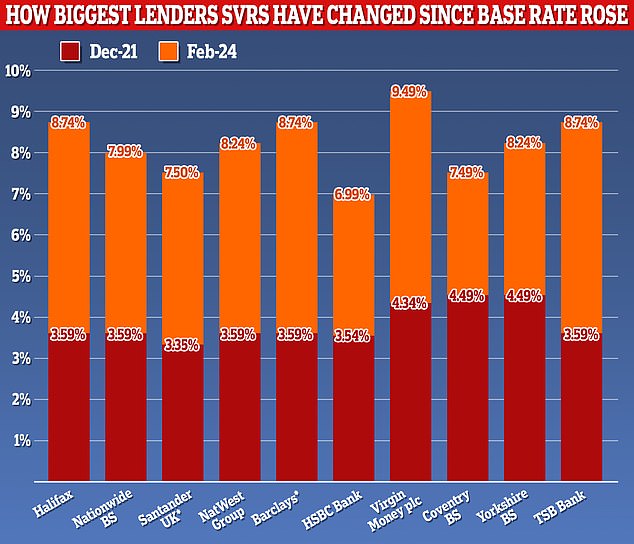
Beware: SVR rates can be as high as 9.73% depending on the lender and can add hundreds or even thousands of pounds to someone’s monthly repayments
Many of those who fixed for either two, three or five years ago will be coming off rates of less than 2 per cent.
Now the average two-year fix is 5.8 per cent and the average five-year fix is 5.35 per cent.
The big question is what those remortgaging this year should do. This is typically a decision between fixing for two years or five years.
Five-year fixed rates tend to be cheaper than two-year deals at the moment. But this, of course, means that borrowers will be locked in for longer and be unable to take advantage if rates fall.
Another option for those looking to chop and change as rates come down, is to consider a variable deal such as tracker rate.
However, they’ll need to choose one without early repayment charges, so they are free to switch without penalty – and this will likely mean they’ll have to settle for a more expensive deal to begin with.
Read our guide on how to remortgage for more information on what to do when a fixed rate or other deal ends.
David Hollingworth, associate director at mortgage broker L&C says: ‘Longer term fixed rates have remained lower than shorter term options due to the fact that markets expect interest rates to fall back over time, once inflation is tamed.
‘That could see borrowers still considering a variable deal despite the potential for further hikes in the hope that they will be relatively short lived before the Bank cuts rates to support a weaker economy.
‘Alternatively they may opt for a shorter term fixed rate in the hope that rates have eased back once that deal comes to an end.’

Around than 1.6 million homeowners will remortgage next year, according to the ONS. Most face a jump in their monthly costs and a big decision about their next home loan
What people decide will depend on their own situation and what they envisage playing out over the next few years.
While many may gamble on rates falling over the next two years and opt for two-year fixes, others may prefer to avoid rolling the dice and instead lock in for longer.
Ultimately, whatever people decide to do, they should always plan ahead. It is possible to lock in a mortgage offer six months before it needs to begin. Borrowers can always then change to a cheaper deal nearer the time.
Chis Sykes, technical director and senior mortgage broker at Private Finance says: ‘We are advising clients against adopting a wait-and-see approach when it comes to locking in these reduced mortgage rates,’
‘While there is a prevailing sense of excitement about the prospect of a rate war or a substantial dip in mortgage rates over the next few months, market conditions largely do not align with such predictions.
‘Individuals can always lock in a mortgage rate today and then re-evaluate the situation if rates fall further down the line.’
Some links in this article may be affiliate links. If you click on them we may earn a small commission. That helps us fund This Is Money, and keep it free to use. We do not write articles to promote products. We do not allow any commercial relationship to affect our editorial independence.







